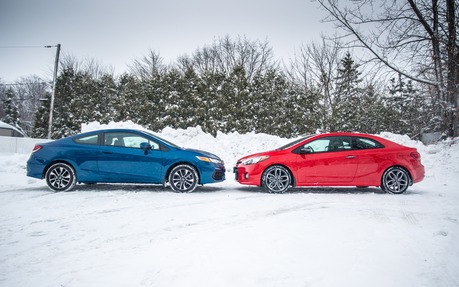Kia Forte Koup vs. Honda Civic: My First Sporty Car
With a steady job and regular paycheque, a sports car fan we know can finally buy his first-ever new car. Jean-Philippe has just landed his first job as a sales associate at a major firm and he has started looking at new cars with a few clear criteria in mind: the car must be good for all seasons, not too powerful (lest it lead to speeding tickets), include just two doors (a sedan will follow at a later stage in life), feature a manual transmission and have a sporty appearance. Performance is important, but not necessarily the top priority. After all, no matter how many horses it’s got, the car will spend a lot of time in downtown traffic. Looks, on the other hand, are at the top of the list. The car should turn heads in the office parking lot and impress the ladies, too.
After considering his options, Jean-Philippe has narrowed the field down to the Honda Civic and the Kia Forte Koup. On paper, they’re very similar and very enticing. How to decide between the two?
Kia Forte Koup: The seductive newcomer
In recent years, sister brands Kia and Hyundai have been two rising stars. It’s not just that their products are on par with the competition, it’s also that the brands have diversified their lineups. Kia is no longer limited to sub-compacts and small SUVs; it now offers intermediate sedans, luxury cars and even sport coupes, like the Koup featured in this article. In fact, in our comparison we used the top-of-the-line trim, the SX. It comes with 18 inch wheels, LED fog lamps, black door handles (to complement the Racing Red body) and dual chrome exhaust tips.
The exhaust hints at the fact that there’s a 1.6-litre turbocharged engine under the hood that produces 201 horsepower and 195 lbs.-ft. of torque. Inside, the driver is treated to a dual-zone climate control, a push-button start, cloth seats with leatherette bolsters, and a six-speed transmission. Like the basic Koup, it comes with heated seats, cruise control, a six-speaker sound system, a rear back-up camera and plenty of other goodies. The manufacturer’s suggested retail price for all this is $25,785.
Honda Civic: A household name
Next to the Koup, the Civic we tested seemed at a disadvantage, as Jean-Philippe was given the EX trim (the Si would have been the closer rival, but the cost of insuring it was out of his price range). The EX is powered by a 143 hp 1.8-litre engine. Its wheels are just 16 inches, and it has one speed less in its manual transmission. Plus it has fewer gadgets. And yet, it has many of the criteria that Jean-Philippe considered essential, such as heated seats, Bluetooth, an infotainment system with touch screen, cruise control and a sunroof (one aspect that the Kia didn’t have). Plus, this car costs considerably less at $21,150.
So on paper, the Kia had the advantage, with more equipment and being more modern in general. It turns more heads because of its more youthful style and because the Civic is all-too-common on the road. At this point in the comparison, I would have declared the Koup the winner and sent our first-time buyer straight to a Kia dealer. But, we still had to drive the two contenders!
Things are different behind the wheel
On the road, things get complicated for our Korean competitor. In normal conditions, we appreciated its power and abundant torque, but the sport suspension proved too firm. Though visibility is OK, there are some annoyances, such as the blind spots and unforgiving seats. Plus, the ride in general left me wanting, as the power steering is light and uncommunicative, despite its three settings (Comfort, Normal, Sport), the accelerator isn’t sufficiently direct and you have to get used to pressing it earlier if you want to downshift smoothly. Even the clutch could have been more precise and communicative; you have to memorize where the friction point is since the pedal doesn’t convey any feeling.
In contrast, as soon as you get behind of the wheel of the Civic, you understand why this car is so popular among Canadians. Its hydraulic power steering is direct and you genuinely feel what’s under the front wheels. The accelerator is lively (just deactivate ECO mode) and the clutch takes no time to get used to. High five to Honda for its outstanding transmission; even though it just has five speeds, it’s precise, easy to shift and as quick as can be. Let there be no question, the Japanese manufacturer knows how to make manual transmissions. When you’re not in the mood for sporty driving, just press the ECO button and the Civic becomes a competent highway car. It used 8.2 litres per 100 kilometres during our test drive, compared to the Forte Koup’s 11.5 litres.
Final considerations: Flash or cash?
Even after the road portion of the test was complete, I wasn’t able to give Jean-Philippe a black-and-white opinion. For everyday driving, these vehicles are essentially equivalent, though the Civic is a bit more fun when you push it. In regular conditions, the Koup is better equipped, its passenger compartment is more esthetically pleasing (despite a few hard plastics) and its superior power and torque is great for city driving. Plus, the Kia is prettier and stands out more, while the Civic is anonymous.
So here’s what it boils down to Jean-Philippe: If you want a car that comes with lots of gadgets and will impress your lady friends, go for the Kia. But if you want a car that is consistently fun to drive, I’d recommend the Civic. As a final consideration, the Civic’s resale value will be excellent, even a few years down the road. This might come in handy when you’re shopping for a family sedan, right?
